Indigenous culture is key to future fashion and a galvanising force for every Australian’s national identity.
Janice Breen Burns reports. (This story first appeared in The Saturday Age/Sydney Morning Herald. Longform: allow 10 minutes read time)
I had an epiphany at the Virgin Australia Melbourne Fashion Festival’s (VAMFF) final show on a muggy Sunday afternoon in March last year. I’d already covered 20-odd high-volt events in the previous two weeks and was hankering for some unglamourous, unspangled banality to reset my frock-coordinates, to return from Planet Fashion. Maybe a footy match later, or an arvo on the couch with Netflix. Just one show to go.
The Global Indigenous Runway. Most VAMFF runways are staged in the gobsmackingly glamourous Royal Exhibition Buildings but this one, a bright blip on the festival’s sprawling independant and arts event calendar, was bumped in to the vast, gloomy, aircraft-hangerish Goldfields Theatre on South Wharf. (Its 2020 iteration went off like a fancy box of crackers this weekend in the same venue.)
Hundreds of us shuffled into seats banked around a C-shaped floorwalk: mums, dads, aunties, kids, and mates of the wannabe designers, models and backstage crews giving new skills a crack to produce the show, and representing indigenous communities – not only Australian, but all Australian-based – around the world.
Then all quiet. A lone young bloke; slick suit, sharp haircut, shiney tan shoes, strolled out of the shadows from backstage (“Men’s tailoring,” I jotted with a “??”) to the corpuscle-pumping huffs of a didgereedoo.
“Walanbaa mari… walanbee yinarr….” (“strong aboriginal woman…strong aboriginal man..”). Singer/songwriter Mitch Tambo sang in a high piping voice and, as he did, peeled off symbolic layers; jacket chucked here, shirt tossed there until, down to belted trousers he plunged his fingers into a bark scoop of chalky paint, smeared jagged stripes across his bare chest and danced, stamping, leaping, chanting, half business-suited city buck, half (I found out later) Gamilaraay warrior, into my psyche.
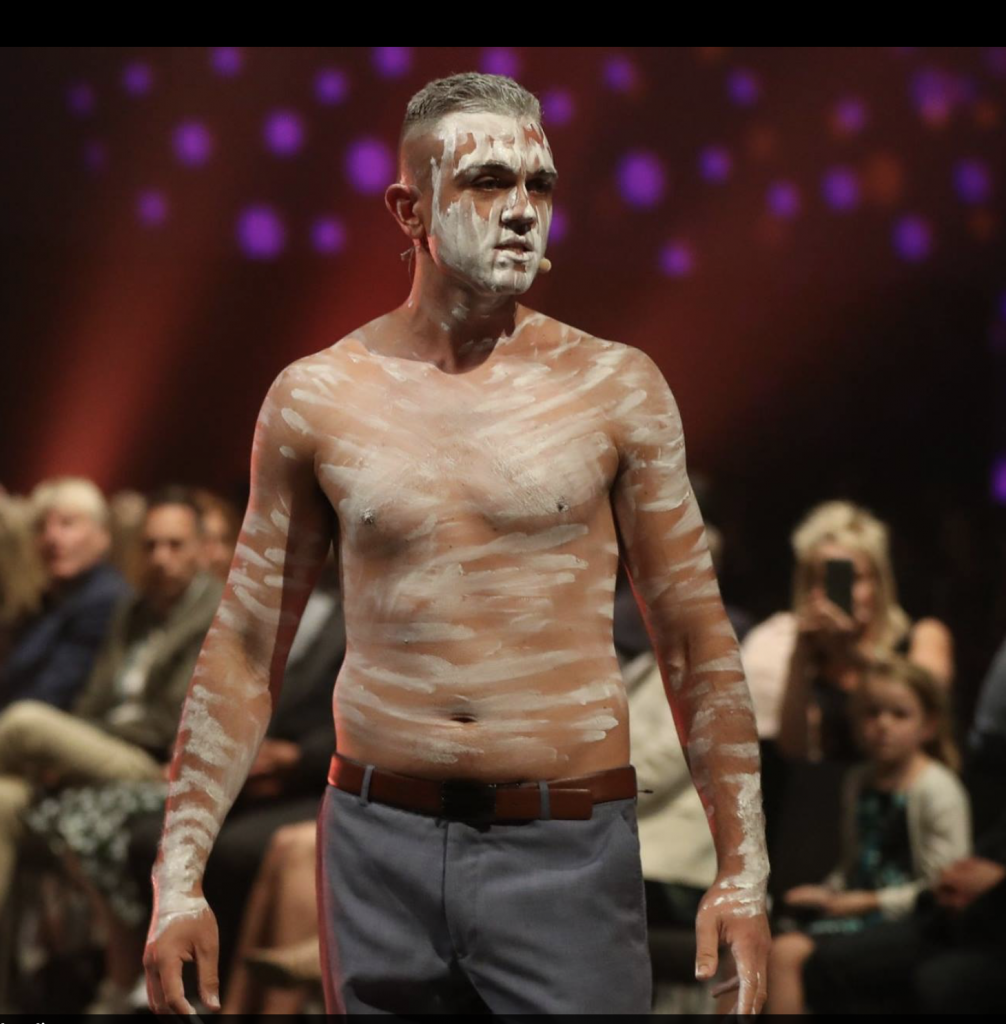
Mesmerising. I could almost feel the metaphorical threads knitting click click together; 60 thousand years of indigenous culture meshing into Australia’s multi-cultural mainstream and cresting rhetoric around reconciliation, treaty and national identity. And it didn’t surprise me all this was crystalising at a frock show either. Au contraire.
Fashion is handily situated on the showy front lines of cultural change, quick to pluck out any conscience-pricking issue percolating in the Zeitgest. So far this millenia it’s thrust feminism, gender equality and fluidity, diversity and racism, body shaming and sustainable and ethical garment production onto its own catwalks, into frockblogs and magazines, through its social media communities and even into trends and collections.
Fashion’s made it uber-cool to be a “woke” mainstream consumer; aware and principled about all the important stuff, calling the shots on what’s right and fair with insta-posts, TikToks and, most crucially, with cash, PayPal and credit cards. Consumers shape fashion’s future and, by ripple effect, fashion shapes popular and mainstream culture.
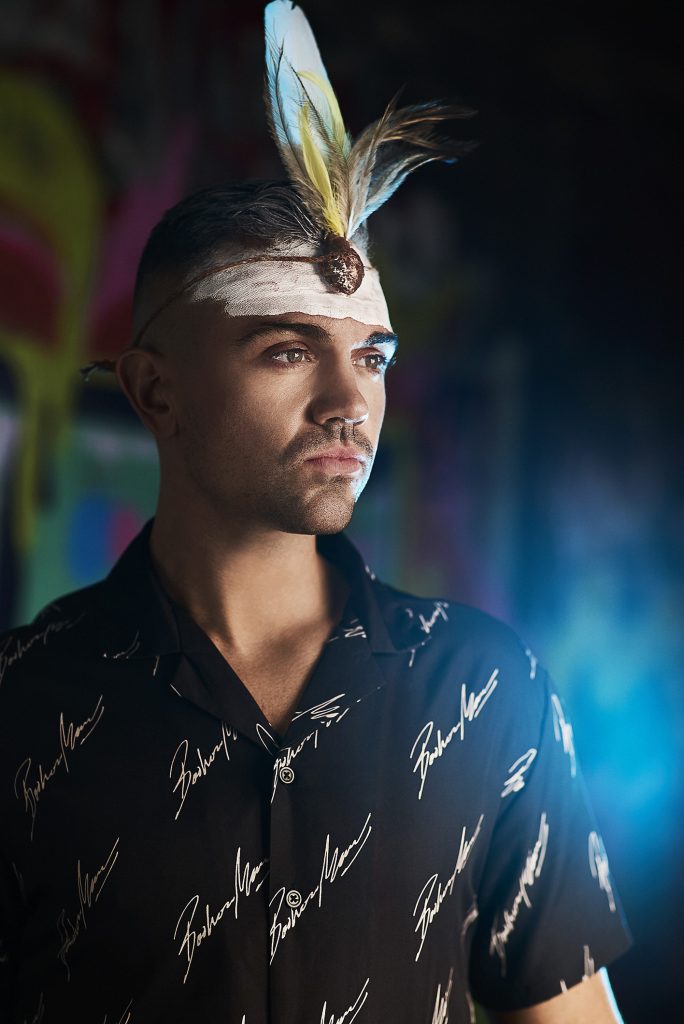
So it was inevitable Australian indigenous culture, simmering so long on fashion’s fringe, would push up to its front line. Inevitable, and logical, and it has, on the dancing feet of a new indigenous “woke” generation: “My culture lives and breathes within my spirit but I also walk in the contemporary world,” Mitch Tambo told me this week, a year after my epiphany. “It’s only right that both worlds come together in the space where I express myself, where I tell my story in the most authentic way possible.”
Main photograph: Lucas Dawson Photography Singer/songwriter Mitch Tambo in full flight. He will perform the traditional “Welcome to Country” and join a discussion panel at VAMFF 2020’s Australian Fashion Summit on March 13.
A lot has happened to Tambo since last year. He’s wowed crowds as a Eurovision contender and with his Gamilaraay rendition of “The Voice” at Sydney’s Fire Fight Australia fundraising concert. But, what marks his moment in the Zeitgeist most poignantly is the pride expressed in his message by non-indigenous Australians. “It’s been amazing,” Tambo says. “The outpouring of love and support from outside my community for my contemporary way of honoring and paying respect to my ancestors, it’s just amazing…”
Tambo will perform “Welcome to Country” for VAMFF’s Australian Fashion Summit on Friday March 13. And, if last year’s sprinkle of indigenous events across the festival’s independant and arts schedule was a breakthrough, this year’s (until March 14) is a tipping point.
Indigenous model Charlee Fraser is the face of a programme heavily peppered with aboriginal artists and designers and, by default, their natural twinning with the festival’s other theme and cause du jour, sustainability.
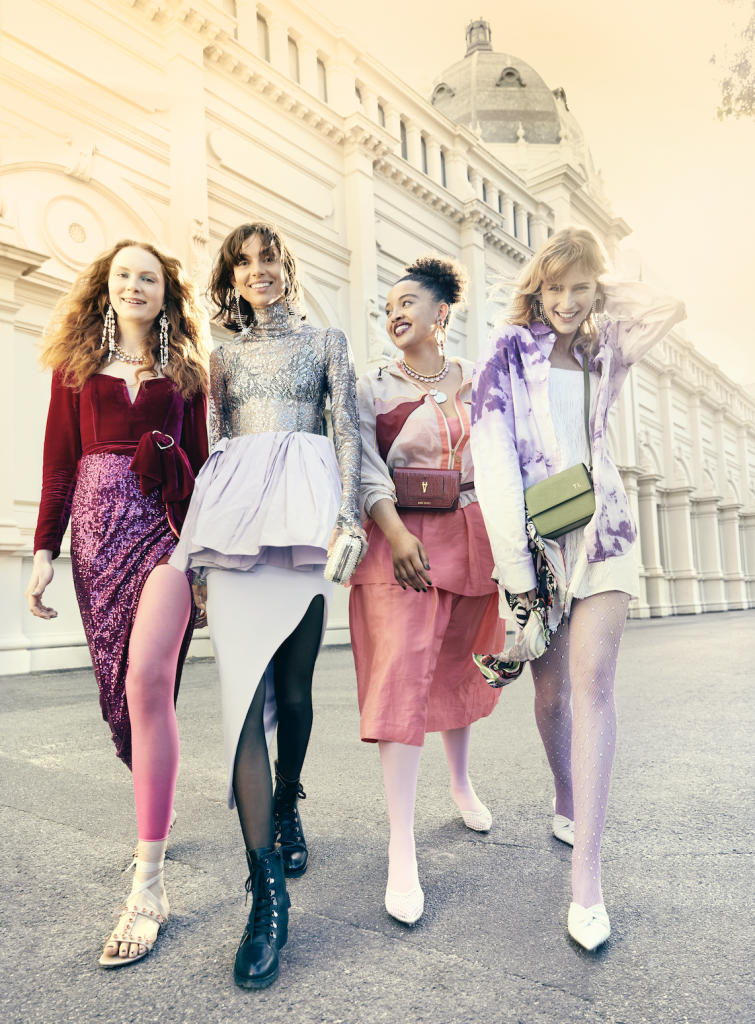
“Fashion’s waking up to what a lot of first nations people have always known about sustainability, upcycling, and not basing (fashion) on wasteful trends,” says Bendigo Art Gallery’s (BAG) First Nations curator, Shonae Hobson. “We have a close relationship with country and the land so everything we do is about looking after it. The rest of the world is slowly catching up to that.”
Hobson is a Kaantju woman, appointed 18 months ago as the gallery’s first dedicated, permanent First Nations curator. That’s a rarity in regional areas and she’s run headlong into its challenges. She remembers particularly, being bowled over and champing to curate her own indigenous projects, by visits to the Cairns Indigenous Art Fair and Darwin Aboriginal Art Fair. Both run exhibitions and runways of fashion and artworks from dozens of desert and urban centres for First Nations creatives. “I knew I wanted to showcase the amazing things happening around Australia in First Nation fashion,” Hobson says. “And I knew the gallery’s reputation for important international fashion exhibitions like Balenciaga was a perfect fit for what I had in mind.”
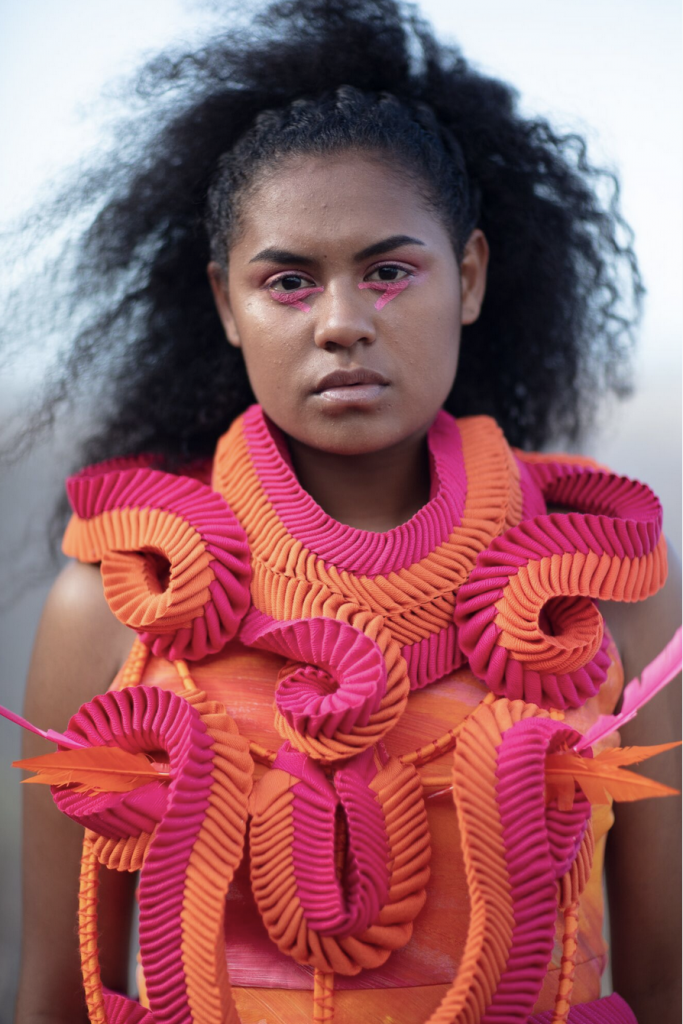
Hobson is currently curating Piinpi: Contemporary Indigenous Fashion, a watershed exhibition by First Nation designers and artists to launch at BAG in July. Ahead of its opening, she’s deepdiving through the complex cultural layers behind its curation by hosting a VAMFF panel this weekend with indigenous fashion designer Lyn-Al Young and National Gallery of Victoria indigenous art curator, Myles Russell-Cook.
“Nothing like this has been done on this scale before,” Hobson says of the exhibition, also destined to form the first kernel of BAG’s ambitious plan for a permanent fashion collection. “This is rich contemporary culture, indigenous storytelling reflective of today, being shared, being translated into beautifully crafted wearable art, silk scarves and fabrics, beautiful accessories.”
She’s picked Cairns designer Grace Lillian-Lee’s brightly coloured origami-esque neck pieces and breast plates among the exhibits, delicately formed by repetitious folding of fabric into thick whorls and snake-like twists. Lyn-Al Young’s airily elegant handpainted silk scarves marked with symbols of her ancestral lands’ waterways and totems are also included and, among many unexpectedly modpop contrasts Hobson hopes will smash any lingering assumptions about what indigenous fashion can be, she’s curated a pumped-up volume frocklet in purple silk organza patterned with Queensland artist, Grace Rosendale’s whimsical “Seed Pods” print design, styled with a madly gorgeous headpiece, an explosion of faux flowers. (Photographed by Bronwyn Kidd for Spectrum’s cover).
Hobson labors the modernity of Piinpi’s exhibits: indigenous cultures don’t just stop evolving, she says, despite their ancient echoes. It makes for a delicate duality in many contemporary art and craft works by First Nations designers. It’s a duality, Hobson believes, that is most intuitively understood by those, like her, who straddle indigenous contemporary and ancient cultures as well as the broader mores of modern Australia.
“Indigenous people have been misrepresented for so long, but we’re taking control of our own narratives and perspectives now,” she says. “It’s important we do; we’ve got that deep cultural understanding of our own stories, our own art, our cultural obligations, ceremonies, traditional practices….we have natural depths of knowledge that just aren’t accessible to a non-indigenous curator.”
In fact, it’s a no-brainer now; the understanding that indigenous artists and designers should control their own commercial outcomes, but fashion, with a few enlightened exceptions, only truly cottoned onto it quite recently. Lisa Gorman’s MangkajaXGorman collaboration with Fitzroy Crossing artists, for example, is often cited as an examplarily fair, slow-cooked and careful arrangement with indigenous artists. But she’s rare.
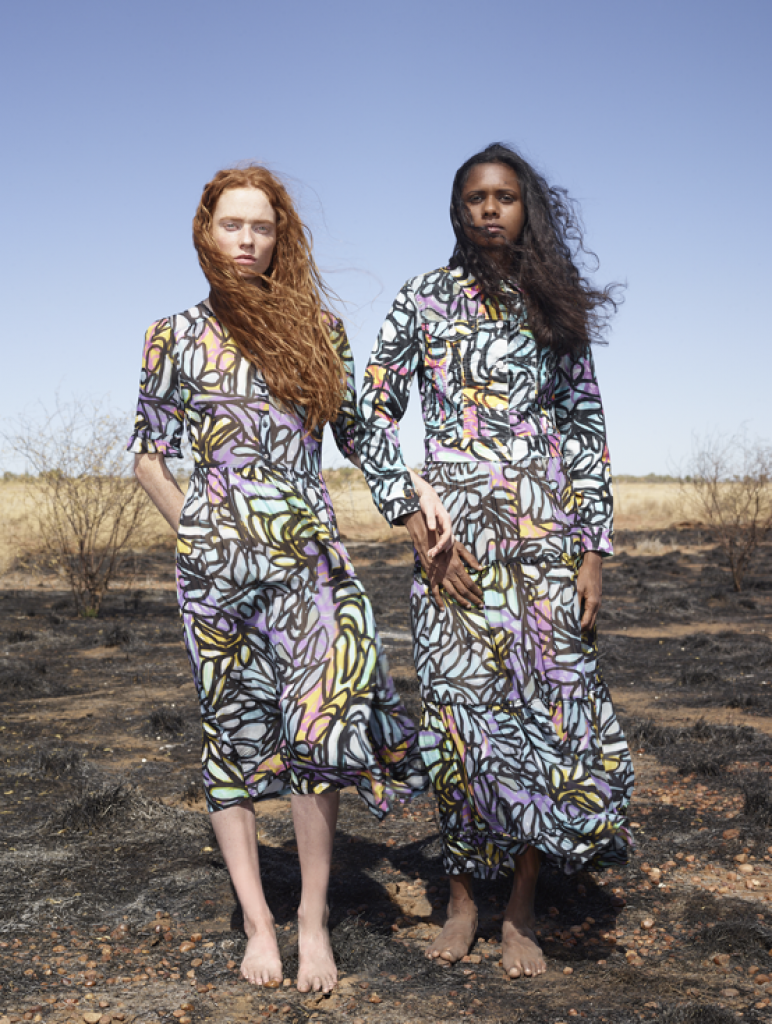
Former CEO of the Australian Fashion Council (AFC) David Giles-Kay, for example, remembers his own lightbulb moment a couple of years ago.
“Indigenous culture wasn’t really reflected in our industry as much as it should have been, yet every time we had a talk or an event, we were always recognising the traditional owners of the land,” he says. “I realised how uncomfortable I was saying it. I knew (the fashion industry) needed to do our part in the reconciliation process… I firmly believe the fashion industry of any place reflects the culture of that place. What was ours? Our indigenous design is incredibly unique, only found here and though there’s always going to be lots of ways that we define Australian fashion, in one respect, indigenous fashion should be part of what people around the world recognise as ours.”
Giles-Kay now consults for the Darwin Aboriginal Art Fair, but two years ago, still CEO of the AFC, he tackled the anomaly by contacting a woman renowned for the links she’s already forged between indigenous artists and the wider fashion industry.
Jen Layton was co-owner for many years of ethical womenswear label, The Ark Clothing Company. With cash from its sale she established Earthed Foundation, a bridge into fashion for artists from Fitzroy Crossing and its Marninwarntikura (Marnin Studio) Womens Resource Centre. She introduces them to fashion people picked for their altruism and interest in indigenous culture who can also help them crack open opportunities to exploit their own work.
“(The artists) want to earn income to help keep their small communities going,” Layton says, “And we want to walk beside them and learn from them and work with them at their own pace. There’s never-ending talent at the top end of Australia, and potential to absolutely explode, but not a lot of access or support.”
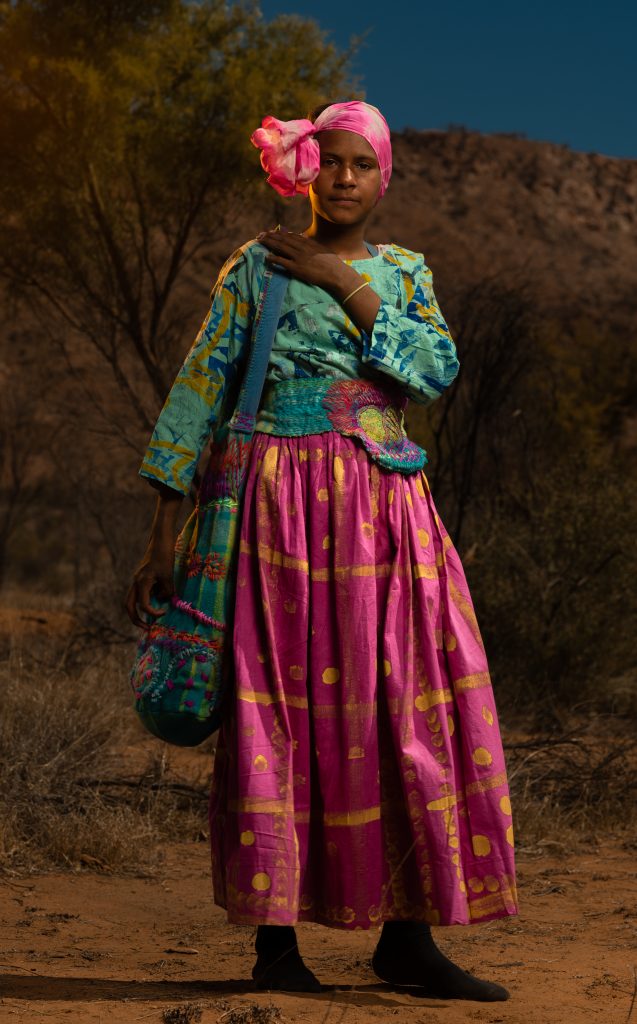
Collaborative fashion from Marnin Studio artists, Fitzroy Crossing. Modelled by Nina. 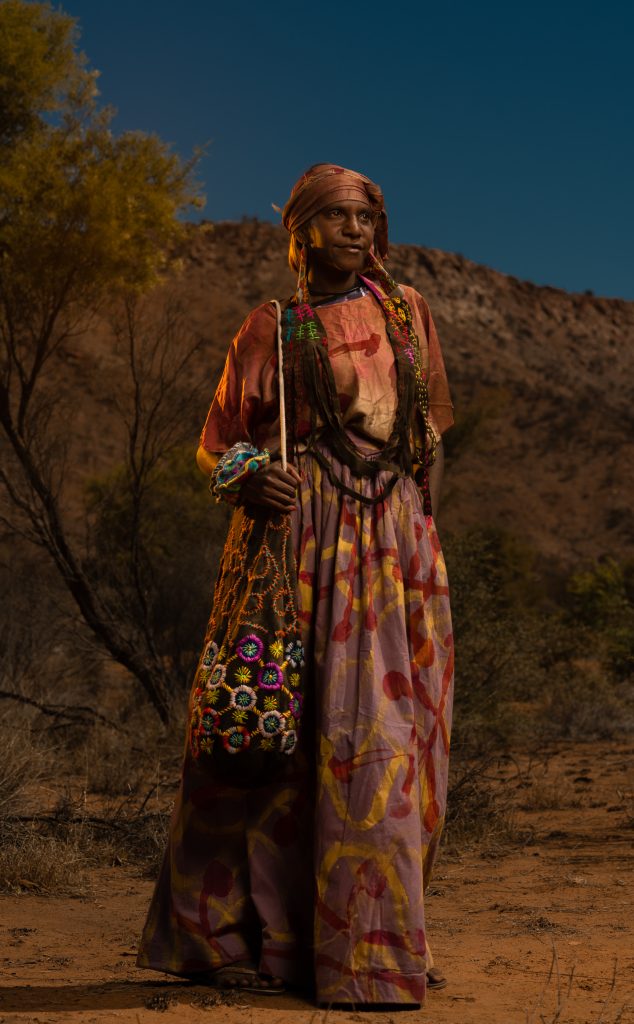
Model: Lekita Malbunka
Collaborations like Marnin Studio’s and Gorman’s are swivel points after decades of exploiters and shonks reportedly flying in, or arriving in gusts of Toyota dust, buying up work by artists in remote indigenous communties for a few bucks, and disappearing to replicate them in prints for thousands of frocks and tops. “That still happens,” Layton says, “They call them Toyotas. We deal with the suspician and mistrust they leave behind.”
The trick to a fair creative collaboration, she says, is to let friendships evolve slowly, everyone’s interest in perfect balance. “It can take years to earn trust. And it’s no wonder.” Layton’s most recent travel companions to Fitzroy Crossing, for example, designer Loiz Hazel and model agent Perina Drummond, had patchy success winning over the locals at first.
Perina Drummond’s first call for wannabe models at the local high school for example, were dismally attended and Hazel’s first sewing classes fraught with suspician. Three years on however, and Drummond’s self-funded Jira Model agency has six young fashion fledglings in high demand including supermodel-in-the-bud Shaniqua.
“Communities tend to be hesitant and that’s understandable,” says Drummond, a Torres Strait islander with a long and mixed history in fashion, politics and indigenous rights and health before she started Jira in 2017. “Leaving (to model) can also be overwhelming so I meet their family, their community, not just them, and, it’s not just about modelling, it’s about life; everything from how to check into a flight, get a taxi..save your money. It’s as basic as that….”
Hazel’s fashion classes are also a roaring success, honeypots for artists in a radius of hundreds of kilometres around Fitzroy Crossing. “They (the women artists) would hang back in the beginning,” Layton recalls, “So shy, all the way across the other side of the room. But by year three, they’re sitting together with Lois, sewing, thigh-to-thigh, chit-chatting and laughing.”
Hazel, an RMIT graduate and renowned independant designer in Melbourne, shares her design, patternmaking and sewing skills in practical ways the artists can use to convert their print designs into luxury fashion pieces for the Design Within Country runway showcasing their work since 2017. “We work closely to create something beautiful together,” she says. “And the demand for it is so high! I remember once, sitting in a shed in the middle of nowhere just sewing away in a corner with (one of the artists) and some tourists found us; I have no idea how. They wanted the (tops) we were making like, straight away. I had to quickly finish sewing while they waited and they paid cash; $150 each…!”
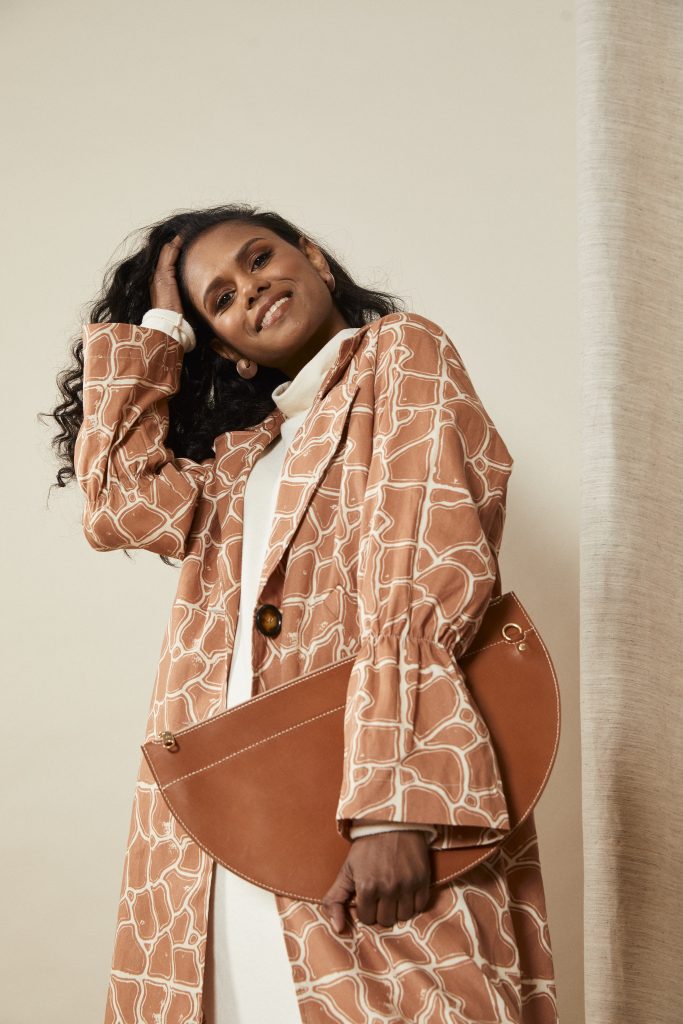
Marnin Studio’s current collection, including a gloriously fleshy hand-printed linen skirt, finely detailed duster coat and hoodie tops and tees, is also likely to sell out in a flash online and through its outlet in Fitzroy Crossing. “They sell out so quickly,” Layton says, “That we’re at a crossroads…” Whether or not to scale up, perhaps to digitally print some fabric, demands thought around originality, sustainability, authenticity. “We have let them consider,” Layton says of the artists, “It will be up to them.”
As it is for every indigenous artist at this swivel point in Australian fashion. Fledgling designer/DJ Sky Thomas, 25, for example, baulks at the idea her joyfully genderless new streetwear label Sawft, launching at VAMFF with a crowd-funded runway and carpark party, might be considered more than usually desirable just because she is indigenous. “Yes, it’s an extremely important part of my life, obviously been a factor in shaping who I am, but it’s not the key of who I am,” says the Darwin born, Melbourne raised designer. “I don’t want people to know me as just: this is Sky, she’s indigenous.”
Thomas’s off-beat and oversized baggy tees, dungarees and jerseys, were more inspired by daggy telly shows and movies: Welcome Back Kotter, Pretty in Pink, Hip Hop Boys in the Hood, than any iconography remotely clicheable as indigenous.
“I didn’t want to be in an indigenous runway,” Thomas says, “I want to show with everything in my life, the complexity and the diversity and everything that people – and indigenous people – can be.”
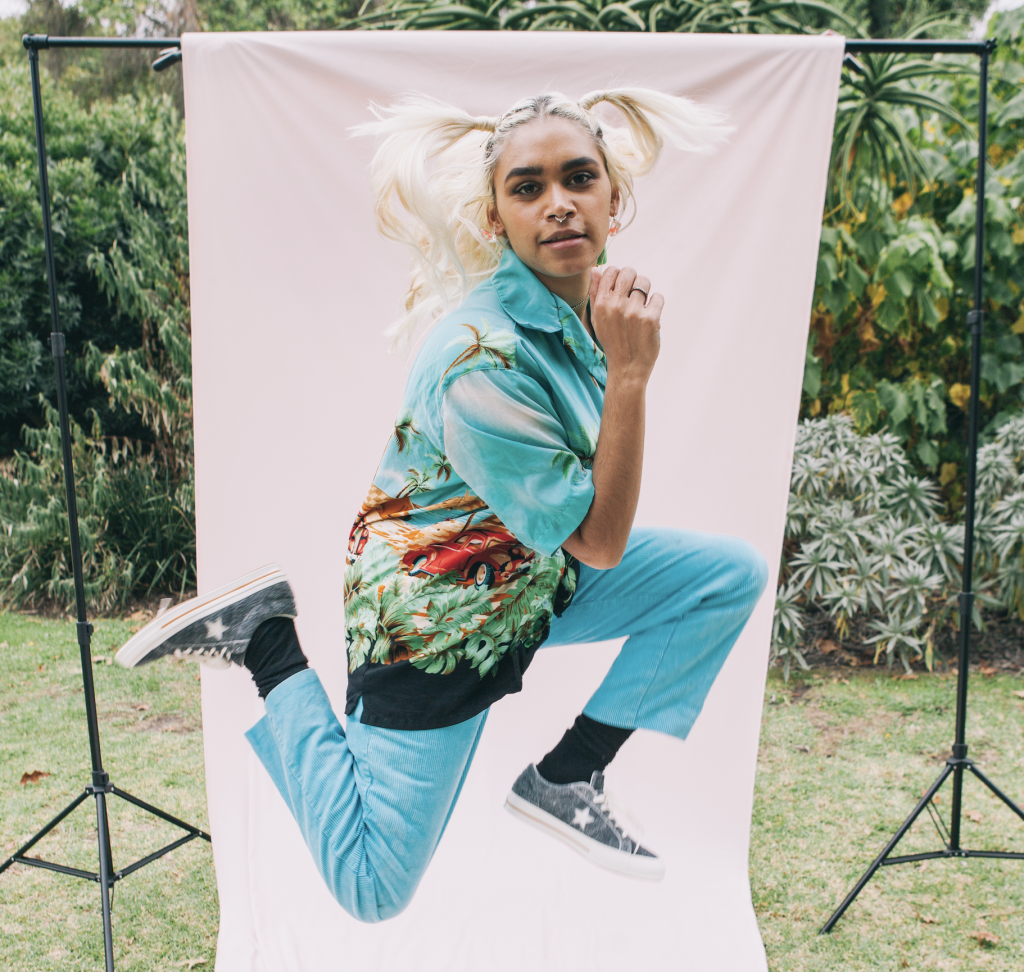
Thomas’s aversion to cliches is a swelling phenomenon according to Myles Russell-Cook, one of two indigenous art curators at the NGV. He’s observed public assumptions shrinking particularly around dot paintings and daubed bark. “We try to smash that expectation that indigenous art will look a certain way,” he says of the NGV’s collection. “Aboriginal culture is as diverse as Europe’s; so many languages, customs, country, people, artists. We have bark paintings and dot paintings, but we also have neon installations, 3-D printing, anything you can imagine in new media works in our permanent collection (by indigenous artists). When people come, we try to hit them with that straight away, to get them to consider what is indigenous art, what indigenous art can be.”
Or for that matter, what indigenous fashion can be.






